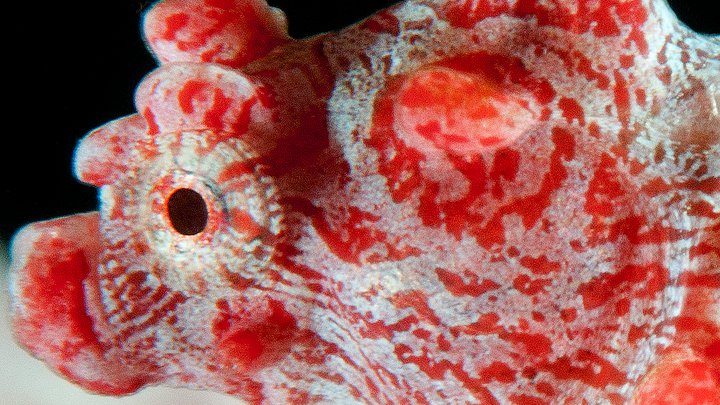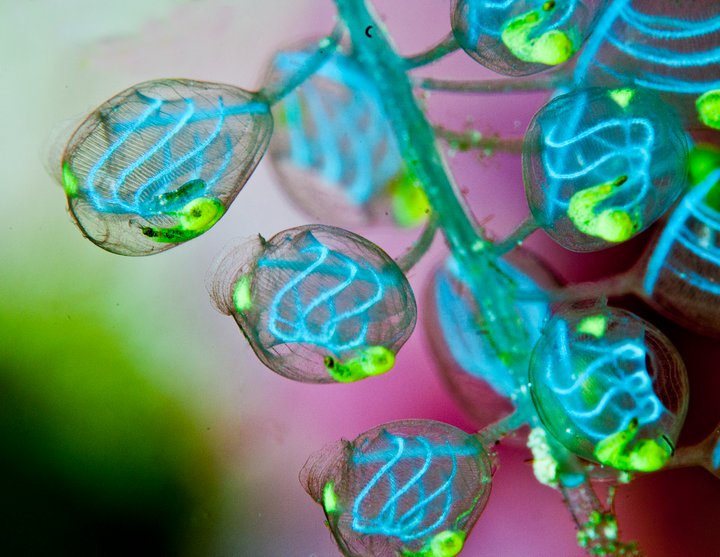Wakatobi in Super Macro
A macro lens is generally defined as a lens capable of 1:1 capture. 1:1 capture means the image on the camera’s sensor is the same size as the actual subject photographed. Since the sensor in a typical digital camera is smaller than a postage stamp, it is obvious that small is the watchword.
But what about very, very small – the tiny? As we magnify a macro image in our camera, it invariably loses detail. Even with the best camera and lens there is a limit to macro photography. Enter the world of super-macro, the art of capture of greater magnification than 1:1.
There are various ways to accomplish super-macro. I chose a +10 SubSee magnifier. My normal lens is a 105mm Nikon lens that captures 1:1 at a working distance (the distance between the end of the lens and the subject) of about 5”. Adding the Subsee reduces the working distance by half but doubles the magnification. I now can capture in 2:1—super macro.
This is what I saw:

Study in RED
This was the most shocking capture. I focused on the eye of this Pigmy Seahorse and achieved focus lock. Later I discovered that I had not captured the entire critter.
Imagine that, a Pigmy Seahorse that was actually too big for the lens!
A little help from Guy and Anita, far more artsy than I, produced this 16:9 shot for the slideshow". It is, in fact a crop of an image shown later.
"These ‘Blue Bells’ are Tunicates forming a colony. I had never even considered tunicates as a subject. It was just another stalk of something! My dive guide, Ana, suggested photographing Tunicates. I took a few shots. This is full frame crpped in only one direction (horizonal).


Study in PARTS
"Watching point-and-shoot photographers review their work, they magnify the shot several times on their camera to see if they captured something successfully. The shot they want is only a portion of the frame. So how much crop is acceptable? To me it depends on how you plan to display your work. Frankly, on the web where the limitation is essentially 1024x768 in sRGB I can crop a bunch, and so can they.
My dive guide Ana is a friend more than a dive guide. She likes PARTS of a critter or coral. She said "There are more beautiful things in the ocean than people photograph". My plan was to crop a 2:1 macro shot to see those beautiful things she was speaking about.
I have photographed Soft Coral many times in macro, usually with a resident Soft Coral Crab. Magnified, it is another experience altogether. This entire “subjects never photographed” gave me a new appreciation of the underwater beauty.
Study in DISCOVERY
"I found it.
I actually found this white Pygmy Seahorse myself.
Prior to this, White Pygmy Seahorses always looked like just another white fleck on the Halimeda Grass. It was much tinier than the red variety.
This is the shot that guests most want. Getting one to look at the camera is very difficult. Getting the entire body viewable, even more so.
Of course this was ho-hum to artsy types. Between the three, Anita, Guy and Ana, they continued to convince me to take more ‘unusual’ “subjects never photographed” underwater".


Study in WHITE
"This Cowry on a Sea Fan was tiny. The detail on the shell is amazing. Our guide, Wayan, suggested this capture.
Notice that the milky white of the shell was captured and the underlying ridges on the shell are present".
Study in TECHNIQUE
Generally I shoot macro in focus priority mode meaning that the subject must be in focus for the camera to take a shot. With super-macro I get closer than minimum focus distance, then withdraw until the subject becomes in-focus and the camera takes a shot.
The problem is that if anything is moving, either the camera or the subject, the camera can't get a focus lock that it finds acceptable. The good news is that most of the shots the camera decides to take are tack sharp. The bad news is the fustration when the camera won't take a shot that looks perfectly focused to me.
The camera is set between f/29-f/32 and the shutter is 1/200-1/250. The INON z-240 strobes are even with and touching the port. My long 9" dual Stix arms really got in the way preventing many shots where an overhang was present.
I did not use my FIX focus light because it too extended well above the housing body limiting flexibility.
Next time I plan single short arms. A ring flash would be good if it was compatible with the subsee.
This is the full frame shot (cropped on only 1 axis for 3:2 to 8.5 x 11) of the first picture


Study on TECHNIQUE 2
"Super macro photography is the world of razor-thin depth of field, even at f/32.
That means that only a small portion of the subject is in perfect focus (if any). On the other hand, if something in-focus is interesting, the shot may be great.
‘Boobs’ is a serious crop of a the Tunicate. Just weird. This file is only 1288 x765 pixels. It could still probably be printed successfully, but people love it on the screen".
Study in: MAGNIFICATION
These are Barrel Sponge Lice
"They look like part of the Barrel Sponge, like little specs of dust all over it. But blow it up, zoom in… they are alive!. Even with a 2:1 this is a serious crop and zoom, but some detail remains".


Study in: DETAIL
"This photo highlighted details never before seen. After posting this photo, what followed was along discussion on what the Bubble Coral Shrimp is actually manipulating. Eggs? No, not eggs.
Neither is the back of the critter covered in eggs. It’s part of the shrimp!
The decision was “stuff”. Stuff scraped off the bubble coral. Ms. Shrimp is eating it. Stuff". It was scraped off the Bubble Coral.
Study in: DETAIL 2
Feeding
"This is a close crop of tiny Flower Pot Coral polyps. I need to try this again. A different angle would be better. Coral Flower Pots, of course, move with the current. Unfortunately any movement, either the camera or the subject, ruins the focus. My 105mm lens, new style, is ultra-fast in autofocus, but still not fast enough to handle any movement". It was most frustrating getting this shot. The problem is that the coral doesn't open and feed without current.


Study in: NATURE
Another shot showing the delicately beautiful arrangement on the stalk.
Study in TECHNIQUE 3
Finally, a simple, super-macro shot of a red Pygmy Seahorse, with a blue tint from eating the fan.
A Pigmy will turn away from the light because it has no eyelids. This is why Wakatobi limits the number of Pigmy shots to five or less. My approach is different. Either the guide or my buddy shine a flashlight on the back of the fan illuminating the Pigmy. Even a very small light is enough. This turns the pigmy towards my camera. Obviously, using a focus light defeats this approach.
Keeping the strobes next to, or behing the port's end, so as to not touch the fan, I withdraw away from the Pigmy until the critter comes in focus. Since the first shot is almost always the best shot, I make sure that I have the proper shooting angle before I depress the shutter and wait until the camera decides it has a focus lock.
I rarely take more than 2 exposures using this method.
I believe that this approach would work with the typical point-and-shoot that focuses about 1" from the port. Just make sure that you touch neither the Pigmy nor the fan.
Hope you enjoyed this.
Tom.
